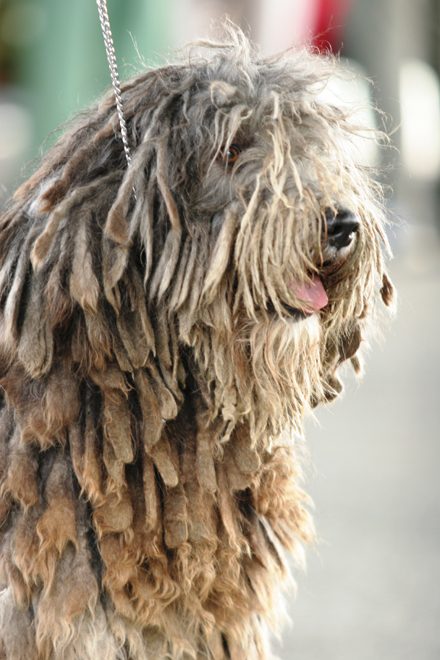A very Healthy breed, the Bergamasco Sheepdog still requires its owner to offer good health care.
It is important to check the ears regularly and treat any ear problems accordingly.
If you look into the Bergamasco’s ears, it is usually pink in color. When you see a Bergamasco scratch his ear on a regular basis you need to look into the ear. One of the signs of an ear infection is a dark brown discharge. You can usually treat a mild ear infection with a prepared boric and acetic solution. If the infection persist, an antibiotic ointment is usually prescribed from your veterinarian.
Feet and Paw Maintenance:
The Bergamasco’s feet should be checked for any possible stone or hard mud that can cause discomfort. Debris can lodge or mud can build up in the hair between the pads. Sometime you will notice a slight limp or he is biting his feet; he may be indicating to you that there is something in his pad. For those of you who have snow in the winter it is especially important to remove ice chinks that can quickly settle under his paws which can cause a cold burn if left too long.
After the dog is 1 years old, you can trim some of the hair between the pads and behind each paw with scissors to prevent ice build up. I often cover our dogs’ paws with Vaseline if they are going to be outside in the snow/ice for a long time, it prevents from ice to form and also protect the pads from ice-melting salt often used which can cause burns on the pads (another great product is “Musher’s secret” or any other wax for paws available in many online pet stores).
Nails:
Nails should be trimmed if the dog does not walk on enough diverse surfaces to have them used naturally. If your dogs have enough exercise outside you will not have to worry about cutting the nails. Your puppy’s rear dewclaws have been removed at an early age so you don’t have to worry about clipping them. You must clip the front dewclaws regularly (or have it done by your vet).
Teeth maintenance:
Beginning around three months of age, puppies start to lose their first set of teeth. The first ones noticed are usually the pointier canines, when an owner notices blood on chew toys. Many times an owner won't even realize his puppy has started to shed teeth.
Adult teeth start to erupt within a few days of losing a tooth, and you'll notice your puppy has started a reign of terror, mouthing everything, chewing like there's no tomorrow.
An adult set has forty-two teeth: twenty-two on the lower jaw (mandible) and twenty on the upper jaw (maxilla). Twelve incisors, four canines, sixteen pre-molars, and four molars on the upper jaw, and six more on the lower jaw.
Brushing Weekly or More
There are dozens of specially formulated toothpastes for dogs on the market now, as well as a number of toothbrush styles.
We prefer the finger brush. Like an infant finger-brush, this is a rubber hood that place over your finger, with soft rubber bristles attached to one side. We find my dogs are less inclines to chew the invading object when they know it's our fingers, and they all know my finger is not edible, no matter how tasty the toothpaste is. After years of using a finger brush, we are reluctant to change the routine now, although dogs do get used to a regular plastic toothbrush quickly enough.
Bones and Tartar Build-up:
This is the easiest part of dental care. Dogs build up tartar and plaque just as humans do. Thankfully, the cure is pleasant to both of us. A good raw, marrow bone, or knuckle bone will keep your dog's teeth free of tartar. The gnawing motion effectively scrapes the entire gunk off your dog's teeth, while you can sit back and relax. The amount of bones your dog goes through will be determined by his size and teeth condition. Our dogs get large hard bone often to clean their teeth. They don't actually ingest the whole bone, but they do make a mess and once the bone has been whittled down, I'll throw it out to prevent them from swallowing it whole by accident.
A Note: Most people recommend skipping bones entirely, and while we acknowledge the fact that cooked bones do splinter and can cause innumerable problems, including choking and perforated bowel, you'll notice that we also take care to recommend only raw bones. Raw bones (uncooked in any way) are soft, do not splinter, and are an excellent source of calcium and entertainment. However they are messy, and in our opinion, the best place for a good chew of a raw bone is either outside with our supervision, or in a room that is easily cleaned (like our kitchen).
Immunization:
New puppies are started with the appropriate vaccination for before they leave for their new home. It is important to have a veterinarian that the new owner trusts. The veterinarian will advise on any required shots during your puppy’s first year based on your location, then will recommend booster or titer test to continue protecting your dog's immunity throughout his life. As your puppy matures, new owners should ask their vet about heart worm medication and parasites.
Worming:
In addition to vaccination, our puppies are treated for worms and other internal parasites. The new owner should make sure to share all this information with their veterinarian on the first visit not to over medicate their puppy. The veterinarian will recommend if any additional worming i needed, if needed, the preparation should be obtained from the vet.





